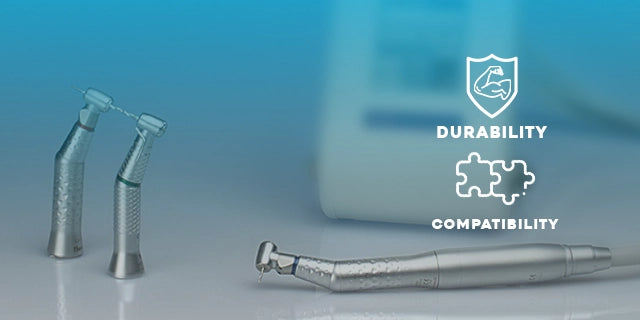Want careful execution of everyday dental operations, the right dental handpiece is what you need. Just try to portray yourself in a dental clinic without having proper dental equipment. Lack of innovative and right products can make your dental ventures difficult. The importance of dental handpieces is undeniable. No matter if you are a seasoned professional or practicing dentistry, the handpiece is the instrument you use most frequently. Using lower-quality handpieces can result in longer procedures and injury to your patients.
Therefore, using the right handpiece can lead to better operational procedures and ease of use.Let’s explore different types of handpieces and some considerations to follow while choosing the right instrument for your practice.
Common Types of Dental Handpieces

Types of dental handpieces are different depending upon their usage and the expertise of dentists. You can explore a huge variety of dental products by visiting our inventory to learn about our products. Here are some major types; each dental handpiece has a different specialty and usability.
Air-Driven Handpieces
Although the use of electric handpieces is more prevalent in the USA, air-driven handpieces have their potential. Air-driven handpieces have a rotational speed of 400k rpm, which helps in fast and hurtless tooth extraction. Moreover, their weight is lighter, which leads to better tactile control. Smaller size, competitive price, and autoclavability of a dental handpiece makes it easier to use, avail, and sterilize.
Electric Handpieces
Electric dental handpieces are the most popular with dentists. Besides, you can say it is the equipment that makes dental operations easy. Its exceptional specs make it the preferable choice for every dentist. The ability to produce high torque results in smooth operations and cutting into harder areas. Moreover, it also features a speed control system, which makes it a versatile choice when it comes to adjusting speed and torque.
High-Speed Handpieces
When we talk about smooth dental operations, a high-speed dental handpiece is no less than others. With efficient and precise functionality, it allows dentists to remove tough tissues easily. Also, dentists can easily adjust and control them, which makes them a versatile choice for restorative procedures.
Low-Speed Handpieces
Low speed has different usability than other electric and high-speed dental handpieces. However, they provide optimum performance for the removal of decay, teeth polishing, and adjustment of crowns and bridges. They can generate more torque than others and need greater control to use them. They extract less heat than others, which leads to a low risk of tooth decay.
Factors to Consider While Choosing a Dental Handpiece
As you know the different types of dental headpieces, it’s time to move forward. With the types of handpieces, you also need to consider many other factors while buying the right dental handpiece. So, let’s dive in:
1. Type of Dental Handpiece
There are many types of handpieces, as we described earlier. Each of them has different functionality and can fulfil your needs differently. So, if one is better for polishing, the other one is better for removing hard tissues. It entirely depends upon your needs and for which purpose you are going to use them. Moreover, as each type offers various advantages, study them carefully before making an order.

2. Ergonomics
Comfort and ease of use are critical. Dentists should consider the handpiece's weight. The grip design and overall ergonomics are also important. It helps to prevent hand fatigue during extended procedures. Electric dental handpieces are a little heavier than others. A lightweight dental handpiece helps to perform dental procedures smoothly. Bad ergonomics results in fatigue and major health issues.
3. Speed and Torque
Speed and torque matter in dental operations. A dental handpiece can spin or rotate on its axis. You may need appropriate speed and torque to perform many operations. For example, high-speed dental handpieces result in low pain and removal of hard materials. Moreover, their versatility also matters when it comes to adjustment.
4. Noise and Vibration Levels
Excessive noise and vibrations lead to discomfort of both the dentist and the patient. Select handpieces that operate quietly. They should minimize vibrations for a more pleasant experience. Moreover, some patients are afraid of drill noise, which causes them discomfort. To increase customer experience, it’s important to use a dental handpiece with low noise and vibrational levels.

5. Durability and Compatibility
Ensure that the handpiece you are buying is compatible with existing equipment. Not only equipment, it should also work well with the existing systems in dental practice. The systems can include coupling systems and handpiece maintenance systems. Moreover, choose the handpiece made from durable and corrosion-resistant materials. Stainless steel and titanium are the most common materials which provide strength and longevity.
6. Cost Considerations
Although the cost factor is important, it should not be the sole determining factor. Compare the prices in the market and compare major brands. Check the types and features of dental handpieces they are offering. Consider the long-term value and performance of the handpiece in relation to its price. Lastly, choose a dental handpiece and enjoy practicing dentistry. Investing in quality may save money on repairs and replacements in the long run.
Read more from us:
From Discolored to Dazzling: A Complete Guide on How to Clean Stained Teeth
Final Verdict
Choosing the right dental handpiece is crucial to increase the overall efficiency and success of your dental procedures. Getting to know the basic types of dental handpieces and then considering some major factors play a greater role. It helps in getting customer satisfaction and provides ease in dental processes. Consider the type, speed, noise, compatibility, and make a wise choice. First, know your preferences and then go for the option that suits you the best.

